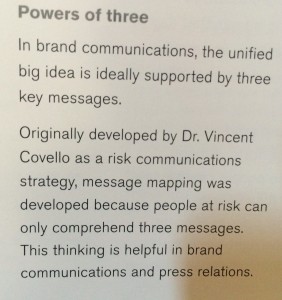

By Mary Branham, CSG Managing Editor
Three is the magic number for people under stress.
That’s according to risk communication expert Vincent Covello.
“People under stress process information not in terms of seven but in terms of three,” he told attendees at the first-ever Economic Summit of the States, sponsored by The Council of State Governments May 20–23. “When a person is upset, worried, anxious, that shift in the brain takes place in three messages.”
Covello, director of the Center for Risk Communication, said there actually are three magic numbers—27/9/3. That translates into 27 words, nine seconds, three messages. He advised state leaders to prepare their messages with the 27/9/3 principle.
“If you don’t keep it short and simple, someone else will make it short and simple for you,” he said.
Covello offered examples of messages during high-stress times in the nation’s history. The effective messages were those that adhered to the principle he described. He cited as examples New York Mayor Rudolph Guiliani’s response after the attacks of Sept. 11, 2001, and Gen. Norman Schwarzkopf’s interview with Barbara Walters regarding the relatively low number of casualties in the first Gulf War.
An example that didn’t follow the principles—and wasn’t received well—was former Defense Secretary Donald Rumsfeld ’s response to a soldier about why the Army didn’t have the protective gear it needed for fighting the wars in Iraq and Afghanistan.
Covello acknowledged that his professional life deals with people’s fears. Risk communication addresses people’s fears related to the things that might be lost or threatened. And it’s the same in several communications fields, he said, including:
- Health, safety and environmental risk
- Crisis/emergency management risk
- Organizational change risk
- Economics risk
- Marital/relationship risk
Government leaders are often faced with situations in which their constituents face some of those fears. Covello said leaders should be prepared to address those concerns, and shared a list of 77 questions that represent 95 percent of those asked by reporters in the first press conference of a major disaster. Those questions, he said, relate to three broad topics: What happened? What caused it to happen? What does it mean?
The earthquake in Haiti and the BP oil spill in the Gulf confirmed it once again, he said.
“This allows you to have a crystal ball to see the future,” Covello told state leaders, “to start thinking about what you’re going to say. It gives you the luxury of time before you speak.”
Covello also shared several templates for response to high-stress situations. Among his suggestions, depending on the situation:
- Show compassion, conviction and optimism. “When people are stressed or concerned, they want to know you care before they care what you know,” Covello said.
- Identify the issue that will cause people to be upset; identify the primary audience and potential questions or concerns.
- Practice and prepare. “When things start happening, there’s a pattern,” he said. “If someone hits the bull’s-eye the first time, you think it’s luck. If they hit it 20 times, you think it’s a result of practice.”
While there are basic rules of communication, Covello said high-concern situations change the rules of communication.
“The key to risk communication success,” he said, “ is anticipation, preparation and practice.”
Source: http://www.csg.org/pubs/capitolideas/enews/issue47_5.aspx






























